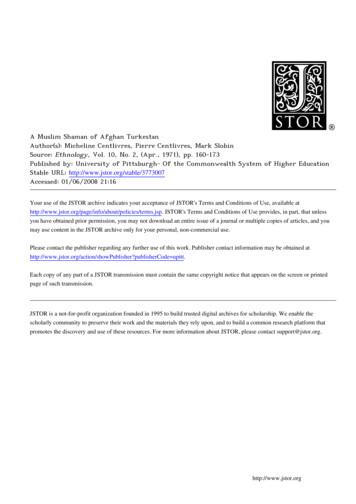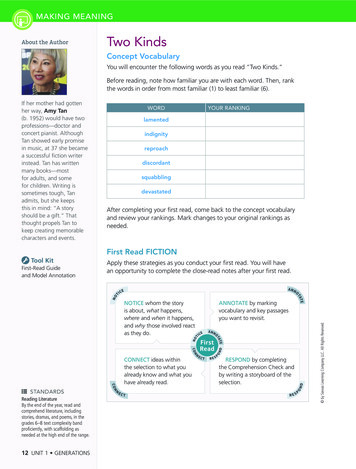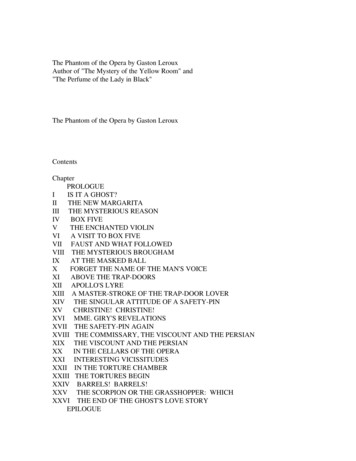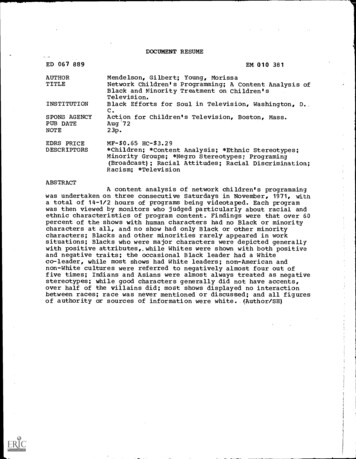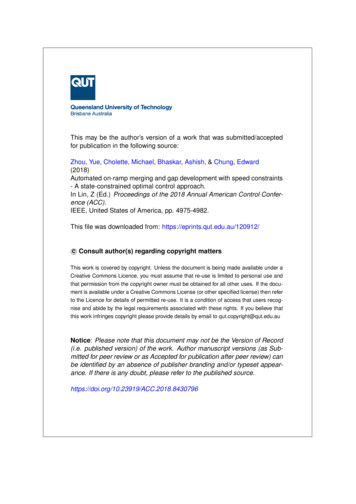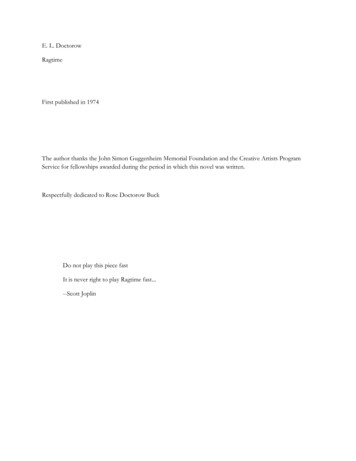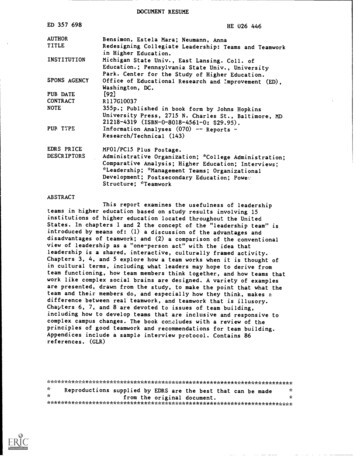
Transcription
DOCUMENT RESUMEED 357 698AUTHORTITLEINSTITUTIONSPONS AGENCYPUB DATECONTRACTNOTEPUB TYPEHE 026 446Bensimon, Estela Mara; Neumann, AnnaRedesigning Collegiate Leadership: Teams and Teamworkin Higher Education.Michigan State Univ., East Lansing. Coll. ofEducation.; Pennsylvania State Univ., UniversityPark. Center for the Study of Higher Education.Office of Educational Research and Improvement (ED),Washington, DC.[92]R117G10037355p.; Published in book form by Johns HopkinsUniversity Press, 2715 N. Charles St., Baltimore, MD21218-4319 (ISBN-0-8018-4561-0: 29.95).Information Analyses (070)ReportsResearch /Technical (143)EDRS PRICEDESCRIPTORSMF01/PC15 Plus Postage.Administrative Organization; *College Administration;Comparative Analysis; Higher Education; Interviews;*Leadership; *Management Teams; OrganizationalDevelopment; Postsecondary Education; PoweStructure; *TeamworkABSTRACTThis report examines the usefulness of leadershipteams in higher education based on study results involving 15institutions of higher education located throughout the UnitedStates. In chapters 1 and 2 the concept of the "leadership team" isintroduced by means of: (1) a discussion of the advantages anddisadvantages of teamwork; and (2) a comparison of the conventionalview of leadership as a "one-person act" with the idea thatleadership is a shared, interactive, culturally framed activity.Chapters 3, 4, and 5 explore how a team works when it is thought ofin cultural terms, including what leaders may hope to derive fromteam functioning, how team members think together, and how teams thatwork like complex social brains are designed. A variety of examplesare presented, drawn from the study, to make the point that what theteam and their members do, and especially how they think, makesdifference between real teamwork, and teamwork that is illusory.Chapters 6, 7, and 8 are devoted to issues of team building,including how to develop teams that are inclusive and responsive tocomplex campus changes. The book concludes with a review of theprinciples of good teamwork and recommendations for team building.Appendices include a sample interview protocol. Contains 86references. ****************************Reproductions supplied by EDRS are the best that can be madefrom the original ******************************
mIDMIXOMING COMAGIUM UhIMPICEPsTU ur OUR IDUCATIONAnna Desna Motl* Nara DensinonCenter for the Stairof Ifigber law satiateDepartment of StaaationalAdministrationMichigan Itaie UniversityPennsylvania State UniversityU DEPARTMENT OF EDUCATIONOnce of Educat.onar Research and ImprovementEDUCATIONAL RESOURCES INFORMATIONCENTER tERICIIns document has been reproduced asreceived from the person or organaatronorrgonat.noo Minor changes have been made to improvereproduction QualityPoints or new or op.nrons stated rn th.s doCo.men, do not necessarily represent officialOERI posrtroo 0 policyProject No.: 1U7G10037CODA No.:BEST COPY AVAILAIRE284.117G
CONTENTSiiTablesiiiIntroduction1.Leadership by Teams:Realitythe Need, the Promise, and the14.TeamsA Different Way to Think About Leadership Teams:as CulturesWhat Teams Can Do: How Leaders Use -- and Neglect toUse -- Their Teams.Making Teams Work: The Art of Thinking Together .5.Searching for a Good Team6.Team Building:Work2.3.2658100.7.8.149It Demands Relational and InterpretiveSpeaking to Administrators: Reconstructing Leadership.as a Collective Practice for Teams and CampusesToward the Creation of Teams that Lead, Act, and Think.Together196.253281319APPENDIX A323APPENDIX B325REFERENCES0.0
TABLESTable 3.1Table 4.1Three Functionsof PresidentialTeamsEight ThinkingRoles fora Presidentialii4Team
INTRODUCTIONWhat is your image of good leadership?If you are like mostpeople you think of leadership as a rare and special talent,power, or expertise that only a few "chosen" individuals arelucky enough to possess.Although the study of leadership hastraditionally focused on such special individuals -- on theirtraits, behaviors, skills, or influence tactics -- there is nowconsiderable interest in looking at leadership, not as a "one-person act," but as a collaborative endeavor.We are beginningto think of leadership, not in terms of single individuals, butin terms of teams.In particular, we see a growing interest inthe dynamics of interactive leadership at the executive level ina variety of organizations, be they corporations, publicagencies, or colleges and universities.We see the theme ofcollective and interactive leadership throughout the professionalliterature:We hear references to "the team as hero" (Reich1987); we hear about the strengths of "integrative leadership(Kanter 1983); and we attend to slogans like, "Forget charisma,focus on teamwork" (Cox 1989).The growing interest in team-oriented leadership has alsoprovoked serious debate.Advocates of the collaborativeperspective contend that team-oriented leadership makes it easierfor organizations to adapt to technologically complex andinformation-rich environments (Zuboff 1988, Kanter 1983,Cleveland 1985).The central premise of the collaborative viewis that learning is the most important activity of modern-dayiii
organizations.Kanter (1983) maintains that collaborative modesof management stimulate the search for solutions "beyond what theorganization already 'knows' (or, to be more accurate, beyoLdwhat its leaders think they know)" (p. 29).Similarly, Zuboff(1988) writes that in the "age of the smart machine" theincreased flow of information demands "a more team-centered,problem-solving orientation" (p. 360) so that organizations arein a position to "maximize [their] own ability to learn andexplore the implications of that learning" (p. 398).In short,advocates believe that a team-centered managerial approachenhances the capacity of organizations to master new knowledgeand to use it effectively to improve innovation, problem-solving,and productivity.Dissenters argue that the collaborative perspective isincompatible with the cultural values of North American society.They also maintain that a team orientation is inconsistent withcharacteristics most likely to elicit superior leadership.Thecrux of the dissenters' view is that North Americanentrepreneurship is made possible by individualism (Fellows1989); leaders (as opposed to managers) are the product ofexperiences that imbue them with a sense of separateness orapartness from those around them (Zaleznick 1989).The debate between the individualist and collectivist campshas occurred mostly through research or through other forms ofdiscourse focusing on corporate organizations, and throughcomparative international studies of organizations.iv0For the most
part, the debate has not yet surfaced with regard to theleadership of academic organizations.Although collegepresidents and other campus leaders often espouse a teamworkideology, what this means for academic organizations specificallyis not clear.Most often, the usefulness of leadership teams istaken for granted, which means that the particular nature oftheir "usefulness" is left unexamined.The Study of Leadershit TeamsOur knowledge of leadership teams is based primarily ona study that we collaboratively planned and implemented.Duringthe course of the study, we visited fifteen institutions, locatedthroughout the United States, twice, first in 1986-87 and againin 1988-89.During our second visit we conducted individualinterviews with the president and up to four members of her orhis leadership team about the nature of the team's organization,functions, and internal dynamics (a copy of the interviewprotocol is provided in Appendix A).In selecting intervieweeswe asked each president to identify up to four individuals whomshe or he considered as members of her or his leadership team.For the most part, the presidents named the chief officers oftypical college and university divisions -- academic affairs,finance and administration, student affairs, rind external affairsor development.We interviewed a total of seventy individuals on1.44
a one-to-one basis, spendingapproximately three hours witheachpresident and an hour anda half with each of the otherteammembers (many of whom carriedthe title of vice president,although others were deans,directors, executive assistants,etc.)Additionally, because wewere collecting these data aspart of a larger study(the Institutional LeadershipProject ofthe National Center forPostsecondary Governance andFinance), wealso conducted interviews withfaculty and trustees.From thesemultiple views wa were ableto construct comprehensiveimages ofleadership processes in thesample institutions.In addition tolearning how the presidentand the persons that sheor he haddesignated worked together as a team,we collected data on howfaculty perceive theiradministrative leaders, includingtheeffectiveness of the president,individual team members(e.g.,vice presidents), and theleadership team collectively.Our database included transcripts ofthe seventy personalinterviews aswell as comprehensivecase studies for each ofthe fifteeninstitutions.Although we spoke at greatlength with the presidentsandmembers of their leadershipteams, we did not observethem atwork as such. All of thedata we present were, therefore,derived exclusively from ourinterviews.The fifteen institutionsinvolved in the studywere diversein type, including fourresearch universities,four publiccomprehensive four-year colleges,four independent colleges, andthree community colleges.Nine of the institutionswere public;vi3
six were private.The sample was also diverse in terms ofprogram emphasis and location, including, for example, a mixtureof urban, su)urban, and rural settings.presidents, four were women.Of the fifteenEleven of the presidents wererelative newcomers to their position (in office for less thanfive years with some only in their first year); the remainingfour had been in office for a minimum of seven years.In keepingwith our promises of confidentiality, we use pseudonyms to maskinstitutional and individual identities, and we refer to allinstitutions as "colleges," regardless of their real type.Wealso use generic rather than institutionally specific titles todesignate roles, governance bodies, college events, etc.The intent of the study was to explore models of teamwork inhigher education, taking into account the leadership orientationsof presidents and their executive officers.Our interest was toexamine how presidents and their designated team members worktogether; how team members perceive the quality of their workingrelationships; how presidents select, shape, and maintainparticularly effective teams; and how teams address conflict anddiversity of orientation among team members.Even though thisbook relies greatly on interview data collected at the fifteenparticipating institutions, it is more than a research report inthat we also rely on the published research of others and on ourown experiences as participants in a variety of groups.We hope that this book will be valuable to college leadersconcerned with building effective leadership teams and promotingvii
teamwork.In Chapters 1 and 2 we introducethe concept of the" leadership team" (oras we refer to it in terms of our study,the "presidential team" or the "topadministrative team").Following a discussion of the advantagesand disadvantages ofteamwork (Chapter 1), we contrastthe conventional view ofleadership as a "one-person act" to the themeof this book -that leadership is a shared,interactive, culturally framedactivity (Chapter 2). In Chapters 3,4, and 5, we explore, ingreater detail, how a team works whenwe think of it in culturalterms, including what leadersmay hope to derive from teamfunctioning (Chapter 3), how teammembers think together (Chapter4), and how teams that worklike complex social brains aredesigned (Chapter 5). In these chapterswe use a variety of caseexamples, drawn from our study,to make the point that what teamsand their members do, and especiallyhow they think, makes adifference between "real" teamwork,on the one hand, and teamworkthat we deem as "illusory" on the other.Chapters 6, 7, and8are devoted to issues of team building,including how to developteams that are inclusive (Chapter6) and responsive to complexcampus changes (Chapter 7).We conclude with principles of goodteamwork and recommendations forteam building (Chapter 8).While the book speaks stronglyto college and universitypresidents, it should also be of interestand use to other campusleaders who want to better understandtheir own (and theirteammates') potential for contribution to a leadershipteam.In an extensive review of leadershipdevelopment programs,viiiI0
Sharon McDade (1987) indicates that at the present time, collegeand university presidents and other administrators have fewtraining opportunities (other than "on the job") for learningabout the workings of leadership teams and about strategies forbuilding effective teams.In this book we give attention to whatleaders can do to strengthen their skills in working with people.Thus we focus on defining the nature of administrativecommunication, the importance of interdependence, the necessaryprecursors of collaboration, and a number of related topics.Wehope that our emphasis on people and what it takes for them towork together comfortably and productively will help to bringsome balance to the attention that professional developmentprograms are currently giving to more instrumental and managerialaspects of individual and team leadership (e.g., budgeting,formal organization, bureaucratic processes).What is a Team?Although all the presidents participating in this studyinformed us that they had teams (easily naming the people weshould interview), we learned very early in our research that theword "team" (like the word "leadership") means many differentthings to different people.Not only do teams differ in thequality of their work (some are better organized, more efficient,ix
etc., than others), but also in theirstyle and in their group"personality." What this means, in part, isthat the experienceof being a team member can vary drasticallyfrom team to team.Here are two examples from our study:Member of Team A:On a scale of 1 to 10 I wouldrate our team a solid 8.We view ourselves assharing in a common enterprise.We don't seeourselves as working in isolation;it is anattitude about the institution.The team is verygood for top-leveldecision-making. For example,earlier this year I wanted toargue for thedevelopment of a new academicprogram.In thepast, I would have convincedthe president, butnow under the new president, Ihave to justify thenew program in the senior staffmeeting. I haveto convince all my colleagues thatthis isimportant enough so that they willgive upresources for it.Working like this is anexcellent way of arriving atinstitutionalpriorities. Someone mightargue that it would beeasier for me to make the decisionalone, but thecollective way is good for me because itmeans Ihave the full support of mycolleagues. In thelong run it makes my job easier.x
members of Team B:If I had to assess our team"D." Weright now I would say that it is around abut not theall work to support the Presidentin two months. In fact, weteam. We have not metwhole team. We mostlyrarely have meetings of theThings werejust talk to each other individually.regularnot always this way. We disbanded ourthere havemeetings about six months ago becausethe budget. A lotbeen tussles over turf and overinform peoplecomes up in my area that I need toreactions to, and itabout or that I need to getof interactionis harder to carry out that kindmeeting as a group.one-to-one. I would preferOthers seem remarkablySome teams work in very "teamlike" ways."team" is not always a team. One ofInshort,aun-teamlike.teamsexamine such differences in howhasbeentoour purposesarewhether certain forms of teamworktoconsiderwork, and alsothe institution -- than others.better -- for the team and forchose to show (rather than to tell)In writing this book, welooks and feels like. To dowhat good and not-so-good teamworkillustrations of life in leadershipthis, we present extensive(and others) do to improve orteams, including what presidentsinaction yields. Unlikehinder teamwork, and what theirmanagement and leadership, wetraditional books on administrativereaderMoreover, we do not provide theprescribe very little.xi
with the conventional(andall-too-simplified) lists of team"do's" and "don't's."Instead, we describethe patterns that wesaw across our sampleinstitutions, and wepresent the voices ofmultiple intervieweesas they portray everydaylife inpresidential leadershipteams.We chose thismore descriptive styledeliberately knowingthat the market isover17 full of "howto" manuals, but mostlybecause we wanted toprovide lifelikeexamples with which ourreaders could identify.The various images oflife in teams thatappear throughout this bookshould be familiar,particularly tothose of our readerswho sit on presidentialteams. We expectthat on hearingother people describetheir teams, thatourreaders will experienceinstant recognition,that they willengage in mentalexclamation: "That isexactly what goes on inour group."Our intent in describingthe "doing" and "thinking"ofteams, their comingtogether and comingapart, the feelings ofconnectedness and alienationthat they engender, isto freeze thestream of team activityand to give the readeran opportunity toexamine, from the outside-in,phenomena that cross theirownlives. Thus we viewthis book as an opportunityfor reflection.We hope that inthinking about theexperiences of otherpeople inother teams that ourreaders will gain insighton those aspectsof their own "team life"that they should activelypreserve andaffirm, and those thatthey should change.And we hope that theywill act accordingly.xii
A caveat:We want to emphasize that in using the term"team," we do not mean a group of people working harmoniously inpursuit of manager-determined goals and in machine-like form(Morgan 1986).Quite the contrary, we believe that a group thatis free of conflict, that takes its cues only from the manager"in charge," and that emphasizes mechanical efficiency over anoften-simultaneous human clumsiness and creativity, is unlikelyto function as a team that leads, acts, and thinks together.Why Write About Collaborative Leadership?Our interest in teamwork dates back to 1986, when the two ofus joined a research project on institutional leadership that waspart of the former National Center for Postsecondary Governanceand Finance.That year we travelled to twenty-eight institutionsto interview presidents, vice presidents, faculty, and trusteesin a massive effort to examine how college leaders interact andcommunicate with one another, how they assess their own and eachothers' effectiveness, how they develop their understandings oftheir campuses, and how they establish goals and transmit values.On returning from our first-year visits we were intriguedwith the idea of leadership as interactive, collaborative, andshared.It became increasingly difficult for us to think interms of individual leaders without referring, at the same time,to their interactions (intended or not) with those around them.
As we wrote our first conference papers and articles, mostly onpresidential leadership, our interest in the balance and tensionbetween individual and collective leadership grew.Our interest in teamwork was also influenced by othersources -- for example, by our observations of people workingtogether in various committees, special project task forces, andresearch teams outside the study itself.In addition, the two ofus have worked together as a team since 1986, experiencing thehighs and lows th4 are bound to come when two very differentpeople enter into a collaborative relationship.Through our owndoing and thinking together, and through our f
program emphasis and location, including, for example, a mixture of urban, su)urban, and rural settings. Of the fifteen presidents, four were women. Eleven of the presidents were relative newcomers to their position (in office for less than

